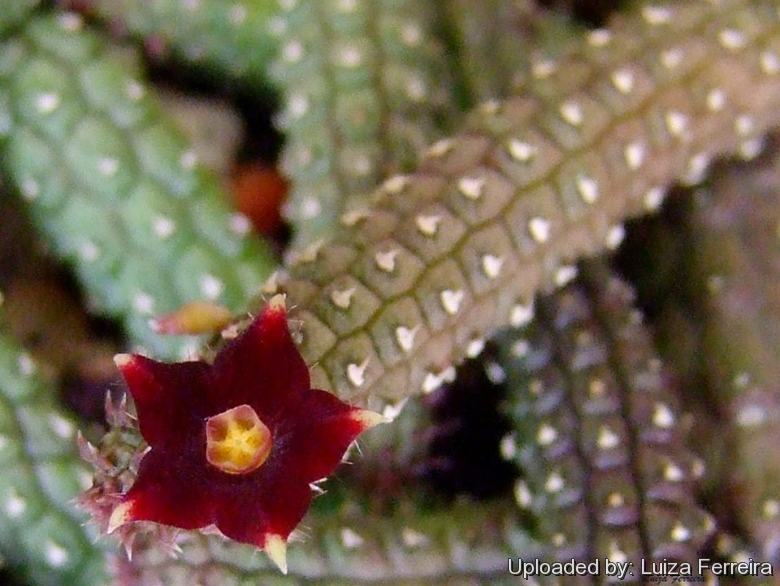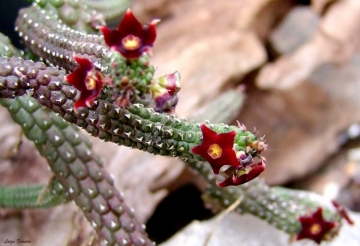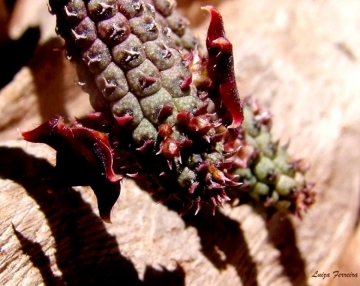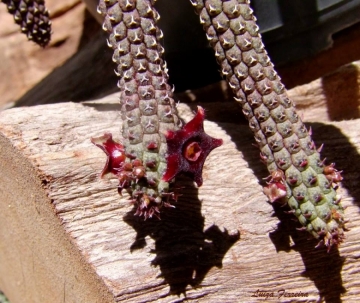
Echidnopsis sharpei Photo by: Luiza Ferreira
Origin and Habitat: Somalia, Kenya and Ethiopia.
Altitude range: 100–300 metres above sea level.
Synonyms:
See all synonyms of Echidnopsis sharpei
Description: Echidnopsis sharpeiSN|30420]]SN|30420]] is a low growing perennial succulent with thin, finger-like stems that form mats as they tend to root along their entire length. The tiny velvety red or yellowish flowers occur in groups of 1 to 2, slightly below the tip and have some reddish hairs on their margins. Two subspecies are recognized by Bruyns (1988), the nominate form and subs. ciliata, but other authors think it best to treated the two as distinct species.
Distinguishing characteristic: Corolla-lobes less than 3 times as long as broad at base
Stems: Cylindrical, up to 15 cm long, 6-15 mm thick (mostly about c. 8 mm), reclining, creeping to procumbent-erect, 8-10-angled, up to 15 cm long, thick, the angles with prominent tubercles. Tubercles rounded or in a variety of shapes.
Leaves: To 2 mm, deltoid, curved down-wards, not erect, falling early or sometimes persistent.
Flowers: In groups of 1 to 2, slightly below the tip of stems, on up to 1 mm long pedicels. Sepals 1-1.5 mm, ovate-lanceolate. Corolla rotate, 6-10(-15) mm across, shallowly campanulate to flat,exterior hairless, green to green spotted purple, interior velvety-bristly, dark maroon to wine red to purple, sometimes yellow or white, sparsely hairy with hairs to 1 mm. Tube very shallow, shortly campanulate, pentagonal, enclosing and laterally touching the side of staminal column. Lobes 3 - 6 mm long, less than 3 times as long as broad at base, ovate-triangular to ovate or triangular, margins strongly revolute, tips revolute and therefore blunt, outside glabrous, inside velvety-hairy. Hairs to 1 mm, white or red, sparse or more dense. Corona 2-2.5 mm across, roundish to deeply 5-sided, sessile. Outer lobes forming usually a deep cup with narrow expanse of tissue at mouth, ivory-coloured, or yellow, or dark red or white with red margins and reddish stripes, with, margin weakly dentate, with long white hairs on inner face (sometime on both surfaces). Inner lobes basally broad, apically narrowly triangular, extending horizontally from the inside wall of the cup, but usually not overtopping the anthers, with some erect dorsal hairs.
Subspecies, varieties, forms and cultivars of plants belonging to the Echidnopsis sharpei group
 Echidnopsis sharpei A.C.White & B.Sloane: (subsp. sharpei) Pedicel 1 mm long. Corolla rotate, 6–10 mm wide dark red, sparsely hairy inside. Distribution: Somalia, Kenya and Ethiopia. 100–300 m.
Echidnopsis sharpei A.C.White & B.Sloane: (subsp. sharpei) Pedicel 1 mm long. Corolla rotate, 6–10 mm wide dark red, sparsely hairy inside. Distribution: Somalia, Kenya and Ethiopia. 100–300 m. Echidnopsis sharpei subs. ciliata (P.R.O.Bally) Bruyns: Pedicel 3 mm long. Corolla broadly campanulate, 12–15 mm wide dark purple, densely hairy on inner surface, tube broad, not adpressed to side of staminal column. Distribution: upper “Sheikh” Pass, Somalia 1440 m.
Echidnopsis sharpei subs. ciliata (P.R.O.Bally) Bruyns: Pedicel 3 mm long. Corolla broadly campanulate, 12–15 mm wide dark purple, densely hairy on inner surface, tube broad, not adpressed to side of staminal column. Distribution: upper “Sheikh” Pass, Somalia 1440 m.
Bibliography: Major references and further lectures
1) M. Gilbert, D. Goyder, J. Lavranos, S. Liede-Schumann, M. Thulin, and J. Venter. "Flora Somalia", Vol 3, (2006) [updated by M. Thulin 2008]
2) James Cullen, Sabina G. Knees, H. Suzanne Cubey “The European Garden Flora Flowering Plants: A Manual for the Identification of Plants Cultivated in Europe, Both Out-of-Doors and Under Glass” Cambridge University Press, 11 August 2011
3) Focke Albers, Ulrich Meve “Illustrated Handbook of Succulent Plants: Asclepiadaceae: Asclepiadaceae” Volume 4 Springer Science & Business Media, 2002
4) Werner Rauh “The Wonderful World of Succulents: Cultivation and Description of Selected Succulent Plants Other Than Cacti” Smithsonian Institution Press, 1984
 Echidnopsis sharpei Photo by: Luiza Ferreira
Echidnopsis sharpei Photo by: Luiza Ferreira Echidnopsis sharpei Photo by: Luiza Ferreira
Echidnopsis sharpei Photo by: Luiza Ferreira Echidnopsis sharpei Photo by: Luiza Ferreira
Echidnopsis sharpei Photo by: Luiza Ferreira Echidnopsis sharpei Photo by: Luiza Ferreira
Echidnopsis sharpei Photo by: Luiza FerreiraCultivation and Propagation: Echidnopsis sharpeiSN|30420]]SN|30420]] is an easy obliging blooming plant, which is happy in any average succulent house. This plant is common to warrant any description, let it suffice to say that this plant is easy to grow and flower, and one which will tolerate most soils and growing conditions.
Soil: Since roots are quite shallow, use a cactus mix or add extra perlite or pumice to regular soil potting soil. A gritty, very free-draining compost is suitable, and clay pots help the plants to dry out between watering.
Watering: They require moderately watering through the growing season but enjoy plenty of water and some fertiliser in hot weather, this helps them to flower freely. Water more sparingly in winter according to temperatures. But, as with most asclepiads, it is unwise to leave them wet in cold weather.
Hardiness: Winter care presents no problems at 5-10°C with plenty of light.
Sun Exposure: Partial sun or light shade.
Pest and diseases: They are generally fairly easy to grow, especially if kept pest-free. They are susceptible to stem and root mealy bugs, and damage from these may well initiate fungal attack. If you do have problems with a stem or with basal rotting, you can reliably isolate the healthy parts, dry them off, and re-root them in moist compost.
Cultural Practices: Re-pot every 2 years.
Propagation: Easiest with stem cuttings. Allow cuttings to dry a day before planting. Stems must be laid (Not buried) on gritty compost and will then root from the underside of the stems. It can also be increased from seeds sowing in spring in moist, sandy peat moss. Barely cover seeds.














